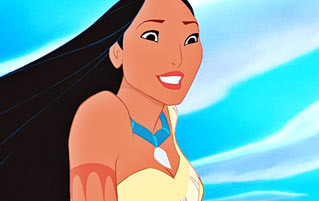5 Historical Figures You're Picturing Almost Exactly Wrong

The problem with our perception of history is that, over the years, the combined forces of Hollywood, gossip, and biased sources have come together to form an indestructible Voltron of ignorance that does nothing but shoot historical inaccuracy into our brains. As a result, many skewed images of famous people have been accepted as "common knowledge" in our cultural imagination despite being completely and provably wrong.
And we don't mean little things like everyone getting Shakespeare's hair color wrong. We're talking about the defining traits of the people who made history. For instance ...
Braveheart's William Wallace Was Actually a Rich Landowner Who Wore Armor
What You Think:
William Wallace has been Scotland's national hero for centuries, but let's be honest: most of us know about him thanks to the movie Braveheart, which makes Wallace out to be a blue-faced, half-naked highlander with all of the murderous, wild-eyed passion of the actual Mel Gibson. However, while the movie obviously took some liberties with his story, it ultimately portrayed the man as an underdog revolutionary leader, which is probably somewhat close to the historical truth, right?

Picture a mix between Robin Hood and Che Guevara, only with more swords and less underwear.
He is portrayed as a common farmer, whose father and wife are both killed by the evil king. He is thus forced to put together a rag-tag band of impoverished misfits to fight the evil empire as best they can. And at least one dude gets stabbed in the dick.
But Actually:
First of all, Wallace wasn't an unwashed commoner in a shit-caked kilt. He was an unwashed knight hailing from a privileged family, and he wore expensive armor. As we've explained before, the kilt wouldn't even exist until 400 years after Wallace's death, and in medieval times, plaid wool skirts would have been about as useful on the battlefield as Nerf swords.

Though they would have come in handy during those sudden diarrhea attacks.
As a prominent landowner whose father most likely served in the household of King David I, Wallace's killin' getup would have consisted of gauntlets, a helmet, and custom-made plate armor. And once he was appointed "Guardian of Scotland," the de facto Scottish head of state, chances are you wouldn't find a trace of caked shit anywhere on his shiny, metal breeches.
Most of Braveheart's take on Wallace actually comes from The Wallace, a romanticized (meaning: "made up") poem written over 170 years after his death by a poet named Blind Harry. More reliable sources, on the other hand, paint a vastly different portrait of Wallace: that of an impetuous, hotheaded knight, "pleasing in appearance but with a wild look," and sporting a giant beard.

In conclusion, the movie's casting was perfect, though a bit premature.
Cleopatra Was Not Beautiful
What You Think:
Even after 2,000 years, Cleopatra's reputation as one of the most beautiful, sexiest women ever persists more than the throbbing boners she gave men like Caesar and Mark Antony. Hell, Mark Antony was so taken by Cleopatra's beauty that he was willing to fight a losing war with Rome rather than give up her vaguely exotic vagina.

"Veni."
But Actually:
If "Hot or Not" had been around in ancient Rome, Cleopatra would have been about a 6, maybe a 7 after a few jugs of some strong Roman wine. See, Cleopatra's ancestors loved them some incest (it is a game for the whole family, after all), and generations of inbreeding had made the Ptolemies of Egypt some famously ugly motherfuckers. Cleopatra was reportedly above average for her family, but even sorta-contemporaries like Plutarch reported that the general opinion at the time was her beauty was "not in itself so remarkable that none could be compared with her." Coins bearing her image show her as rather butch and hook-nosed, leaving modern historians to describe her with tortured euphemisms like "majestic."

"She also had a great personality."
Despite being kind of "meh" in the face department, Cleopatra was renowned for being able to get into the head (and pants) of any guy she wanted using only her wits. Seduction and manipulation came to her as easily as breathing, and it frightened Romans that a woman, a plain one at that, could out-politician them with nothing but the power of her brain, which ancient scientists weren't even sure women possessed. In other words, it was simply less damaging to their egos to reduce Cleopatra's shrewd intellect to, "She was really hot, bro." Strategy and charisma are male traits, dammit!
The Real Buddha Was a Somber Guy With an Average Body Type
What You Think:
Go to any Chinese restaurant and you'll have to endure a fat ol' Buddha statue, laughing and smiling as if to remind you of the long-term effects of Kung Pao chicken on the human body. Apparently, after becoming one with the universe, the Buddha felt that all his ideas about "moderation" were dumb and proceeded to really let himself go. At least he seems happy with his destructive lifestyle choices:

"I'm not laughing! I'm having a stroke! Call 911!"
But Actually:
The "Laughing Buddha" you're thinking of is actually a happy soul called "Budai," an eccentric Chinese monk known for his joyful, loving personality. He's a popular symbol of happiness, satisfaction, and abundance in China, which is why Chinese restaurants in the West often treat their guests to the sight of a big Budai while they eat. And because "Budai" and "Buddha" sound alike, over time ordinary folks made the mistake of confusing the constantly smiling fat guy for the symbol of Buddhism, the belief system that teaches that happiness brings you closer to enlightenment.

And what is happiness if not a bucket of KFC and a case of beer?
There is also the important distinction between "a Buddha" and "the Buddha." Siddhartha Gautama was the guy who conceived the philosophy of Buddhism, and he is what Buddhist mean when they're talking about the Buddha. However, because Budai is considered to have achieved Nirvana, he (like hundreds of other monks) is officially designated as a Buddha, just not the original one. They're similar, but you shouldn't mix up the two, because that's like confusing Jesus with Santa Claus.
The real Siddhartha Gautama spent large portions of his life living in both luxury and severe poverty, and the lesson he learned from those experiences was a resounding "screw that" to both of them. The essence of Buddhism has always been The Middle Way and finding a happy middle between two extremes. That's why, despite "skeleton Buddha" statues depicting Siddhartha's lean years being quite popular in Asia, the historical Buddha probably wouldn't want them or Budai to represent him. Someone with the physique of Will Ferrell would be way closer to the mark.
Pocahontas Was a Bald Exhibitionist Who Later Wore Pimp Hats
What You Think:
Thanks to the Disney movie, Pocahontas has today become the definition of an "Indian princess": a strong, dark-haired beauty in fashionably cut buckskins who talks to trees, paints with all the colors of the wind, and teaches the white man to live in peace with the natives. In the process, she falls in love with Captain John Smith, a storybook ending if there ever was one.

And the Americas knew no conflict from that point on.
But Actually:
We've already talked about how Pocahontas' real name was Matoaka, and "Pocahontas" was a nickname whose most charitable translation is "frisky." How did she earn it? Well, it might have something to do with all those naked cartwheels she used to do in front of the Jamestown settlers. But put your boners away, because she was, at most, 12 years old at the time, which also makes all your "Poke-her-hot-ass" jokes as creepy as they are lazy.

Super creepy.
Not only is it almost certain that Pocahontas first encountered John Smith in her birthday suit, she probably did it with her head shaved completely bald, which together with a ban on clothes was customary for all prepubescent girls of her tribe. But, wait, wasn't Matoaka John Smith's girlfriend? Actually, no, they were never lovers in real life, which acquits Smith of being a pedophile with a cancer-patient fetish.
Something else you can add to the list of debunked Pocahontas myths: she wasn't a princess, since her tribe had no such concept. She "became" one after being taken to England, where it was just easier to call her a princess than to explain Native American tribal hierarchies. Make no mistake, though. She wasn't seen as foreign royalty but more as an exotic curiosity and an example of a "civilized" savage, which was evident by her having married a dude named John Rolfe, changing her name to Rebecca, and wearing some hilarious hats.

Now available at Coachella for just $39.99!
William Shakespeare Sounded Like Your Drunk Uncle Doing an Offensive "Irish" Accent
What You Think:
If you're going by movies (or plays, if you're fancy) based on Shakespeare's works, you probably think everyone involved sounds like Sir Laurence Olivier reading a Medieval Times menu. That's presumably one reason the kids aren't much into Shakespeare these days, or it might have more to do with teachers continuously keeping Shakespeare's best material (by which we mean filthy sex jokes) out of the classroom, or the fact that the Bard once tried to rhyme the words "proved" and "loved" in his "Sonnet 116."

You can fail a middle school creative writing class for that, right?
But Actually:
Believe it or not, back when Shakespeare first wrote "Sonnet 116," "loved" and "proved" did rhyme, because they were pronounced differently than they are today. Accents constantly evolve, as regional mingling and personal quirks gradually change the flavor of the English language over time. That's why some scholars say that Shakespearean readings aiming for some level of authenticity should sound less dignified and grandiose and more like Hagrid telling a dirty joke at a strip club.

"And that's why you never get your huffle puffed without a sorting hat."
If you can't hear that in your head, here's linguist David Crystal demonstrating Shakespeare's original pronunciation by having his son Ben first read Henry V in sexy modern English, followed by the strange moon-tongue of 16th- and 17th-century London that sounds like a mix of Irish, Welsh, and Appalachian:
So in "Sonnet 116," "proved" was pronounced closer to "pruvved," rhyming comfortably with "loved," which actually segues nicely into Shakespeare's secret whore-fucking. You see, after literary scholars realized that Shakespeare wasn't actually bad at rhyming, it allowed them to discover a ton of smutty puns cleverly hidden in his works, like in As You Like It:
And so, from hour to hour, we ripe and ripe,
And then, from hour to hour, we rot and rot;
And thereby hangs a tale.
It's now believed that "hour" is a homophone for "whore," "ripe" for "rape," and "rot" for "rut," and with that in mind, this cynical rumination on mortality suddenly becomes a story about a guy bragging about endurance fucking.
For more things you're just so wrong about, check out 44 Important Parts of History You're Picturing Wrong. And then check out 20 Things Everyone Pictures Incorrectly (Side by Side).
Surprised? Help share the truth, click the Facebook button below.





